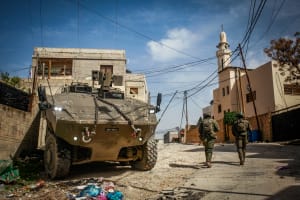Hamas sought Iran and Hezbollah support for Oct 7 attacks, planned 9/11-style attack on Tel Aviv
Group planned even larger attacks, assumed its allies would join immediately

The IDF shared documents with journalists from The Wall Street Journal, The New York Times, and The Washington Post demonstrating that the Hamas terrorist organization planned the Oct. 7 attack on southern Israel for years, and even delayed it while seeking support from both Iran and Hezbollah.
The documents, most of which the IDF claimed were found in the Hamas stronghold of Khan Younis during raids in January, show a variety of planned attacks in Israeli cities, including Jerusalem and Tel Aviv. They also revealed correspondence between Hamas leaders and Iranian officials.
Several of the planned attacks appear to have been abandoned by the terror group due to a lack of feasibility, while others never appeared to pass the initial idea phase.
Some documents show Hamas leaders, particularly Yahya Sinwar in Gaza, attempting to persuade the Iranian regime and the Hezbollah terror group, located on Israel's border with Lebanon, to join in the planned attacks.
The New York Times revealed that documents of planning meetings demonstrate that Hamas had planned to carry out the attacks one year earlier, but delayed them as it tried to persuade Iran and Hezbollah to participate.
Hamas tried to convince Hezbollah that Israel’s “internal situation” – likely referring to the social unrest over the judicial reforms protests - called for a “move toward a strategic battle.” A Hamas official was sent to Lebanon in July 2023 to meet with Iranian and Hezbollah leaders to ask for aid.
The documents also show that Hamas leadership was pressured into acting without full support from Hezbollah and Iran based on two concerns: efforts to achieve normalization between Israel and Saudi Arabia and the upcoming deployment of Israel’s Iron Beam air defense system.
The documents also revealed that Hamas deliberately misled Israel into believing that it was not interested in a large-scale conflict. The documents refer to the need to “camouflage the big idea” or “the big project.” Meeting minutes in 2022 included statements of relief among the leaders that Ramadan had passed without a major incident.
Later that year, after provocations by radical Jewish nationalist groups during the annual Jerusalem Day Flag March passed without incident, the leaders again expressed relief that their “big project” was not exposed.
Documents also revealed that Sinwar approached Iran for help in funding the attacks in early 2021. One of the documents confirmed Iran’s allocation of $10 million to Hamas’ Al Aqsa Martyr’s Brigade, while another document, just a few weeks later, shows Sinwar asking for $500 million to be paid out at $20 million per month.
“We promise you that we will not waste a minute or a penny unless it takes us toward achieving this sacred goal,” Sinwar wrote in a letter from June 2021.
The documents contain minutes from meetings of senior Hamas officials in Gaza, indicating that Yahya Sinwar was present at each one, while others show that officials, including Mohammed Sinwar, and now-deceased Mohammed Deif, attended at least several of the meetings. Hamas leaders sought to limit knowledge of the developing plan only to those who needed to know.
While the “big project” was discussed among Hamas leadership, even as early as 2021, it appears to have taken its final form in 2022 and 2023.
The Washington Post reported initial plans were much broader and included a Sept. 11-style attack on the Azrieli Towers in Tel Aviv, which was later abandoned. A 36-page slide presentation entitled, “Strategy to Build an Appropriate Plan to Liberate Palestine,” was also discovered. The presentation contains maps, photographs and schematics of a variety of potential Hamas attacks on Israeli targets.
“We present to you this vision, which talks about the appropriate strategy for liberation in the near future, God willing,” the opening of the presentation stated.
By the fall of 2022, the plans had cemented around the strategy of attacking military bases first, to distract attention while the group launched additional attacks on residential areas.
As late as August 2023, Hamas was still trying to convince Hezbollah to join in the attack, saying it would need their support attacking Israel targets during “the first hour” of the assault.
The documents appear to assume that Hamas’ allies, Iran and Hezbollah, would join the fight as soon as they saw its initial success. One of the documents speaks of "linking and preparing the external fronts [Lebanon, Syria, and Sinai] and agreeing on mechanisms for communicating peacefully and in war.”
Ultimately, Iran did not join the fighting, while Hezbollah provided limited support with rocket attacks on Oct. 8, one day after the Hamas invasion and terror attack last year.
The Permanent Mission of Iran to the UN did not directly respond to the reports of the IDF's discovery of the Hamas' planned attacks, however, when responding to questions from The Washington Post, it accused Israel of sharing disinformation.
“We regard the Israeli regime as a mendacious criminal, anti-human entity and place no credence in their illusions,” a spokesman for the Iran UN mission said. “They have a long history of spreading falsehoods, fabricating already-counterfeit documents, and conducting deceptive psychological operations.”

The All Israel News Staff is a team of journalists in Israel.














